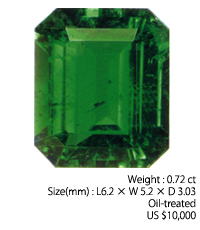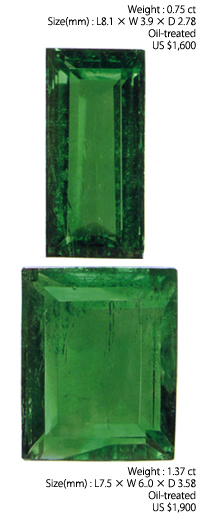CHARACTERISTICS BY MINING DEPOSIT
Colombian emeralds represent about 50 percent of worldwide emerald production. Approximately one hundred mines there have been alternately mined ever since the Spanish conquest in the 16th century. Colombian emeralds have characteristics that vary from mine to mine, with qualities so diverse that they even vary according to specific areas within the mining regions. Let’s compare the difference between emeralds found in the representative mining regions of Muzo, Chivor, and Cosquez.
|
 |
Muzo
Located 120 kilometers (72 miles) north-northwest of Bogotá, this deposit is noted for producing the finest emeralds. More yellowish than emeralds from the Chivor mines, they have a characteristic deep green with a soft hue. However, highly included material lacking in beauty due to low transparency or poor color makes up the majority of production, with gem-quality material constituting less than 1 percent of the total. Add to this the material not fit for polishing, and stones of gem quality are believed to be about one in 1,000.
|
|
Chivor
The Chivor mines, located 100 kilometers (60 miles) east-northeast of Bogotá, produced emeralds that are more of a bluish green than those from the Muzo mines. Though mush of this material is only lightly included and highly transparent, it does not compare to the soft appearance of the gem-quality stones from Muzo. Material mined in Chivor also varies greatly in quality, with limited material worthy of polishing. |
 |
Cosquez
The Cosquez mines are located 10 kilometers (6 miles) north of the Muzo mines. Controlled along with the Muzo mines by government supervision, production has been held back. The quality of this material is of a light green as shown in the photograph, and can easily be separated from the material mined in Muzo and Chivor. |
|
 |
JUDGING QUALITY
Emeralds are said to be the most included of all gemstones. When colorless, beryl has few imperfections, but the presence of the color-causing chromium or vanadium impurities introduces stress during crystallization, causing many imperfections and fractures. Presently, nearly all emeralds are treated with colorless oils or resins. Tiny fractures within the stone that reach the surface are filled with oil or resin in a process intended to make them less visible, thus making the stone appear more attractive. Such cosmetic treatment has been going for on several hundred years and poses few problems, but material subjected to extensive treatment may initially appear to be of deceptively high quality. There is a possibly that the filling material may decompose over time, making the fractures more visible and the stone less attractive. The presence of surface-reaching fractures becomes a key factor in judging quality.
A Colombian emerald with a 6S quality has a high degree of transparency in spite of its dark color, and is of a quality that possesses a delicate beauty rarely seen in nature.
|
| |
HOW TO CHOOSE
When choosing a Colombian emerald if 0.5 to 3 carats of gem or jewelry quality, it is important to select one that has few surface-reaching fractures that might be treated with oil. Because rough Colombian emeralds occur in a hexagonal cylinder shape, most material is fashioned into emerald cuts, with a limited number of stones being cut into fancy shapes. Choosing a basic emerald cut offers a wider selection and can be considered a wise decision.
To enjoy a large stone, choose one of jewelry quality. In contrast to rubies or emeralds from other sources, Colombian emerald rough is relatively large in size, with per-carat prices rising only moderately as stone size increases. Therefore, larger Colombian emeralds are more reasonably priced than other large gemstones. Advice from a merchant with extensive product knowledge is the key concerning surface-reaching fractures.
|
|